Sustaining our future across disciplines
Balancing act
By Michelle Geering
A farmer in western Kansas worries his well will be dry in 30 years. More than 9 million tons of clothing — some items only worn once — go to U.S. landfills each year. Globally, 79% of all consumer plastics end up in landfills or as litter and can take hundreds of years to decompose.
These are a fraction of the sustainability challenges the world faces. If current behaviors and practices are left unchanged, experts say the consequences to our livelihoods and for the environment are bleak.
But all is not lost: A variety of measures and practices can help overcome these challenges. Kansas State University researchers are working across disciplines to engage in sustainability, which meets today’s needs without compromising the ability of future generations to do the same. It’s a balancing act.
Futuristic farming
For engineer Vaishali Sharda, providing tools and information to make science-based decisions is what drives her work to protect and sustain the food production system.
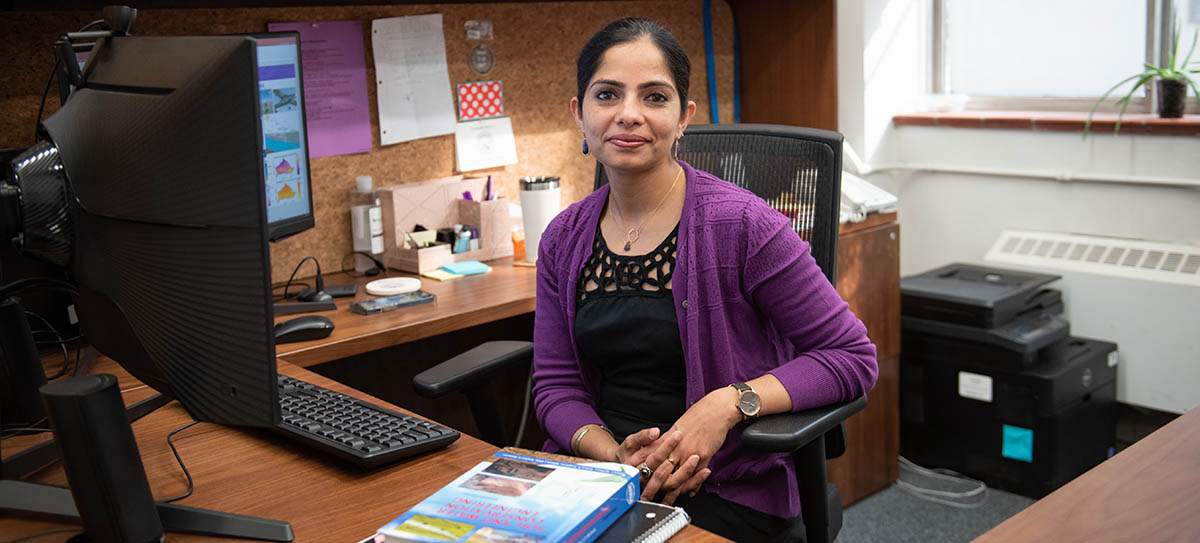
Above: Vaishali Sharda studies how the changing climate affects food systems and water preservation.
Much of Sharda’s research focuses on the effects the changing climate has on food systems and, most extensively, on preserving water. She uses computer modeling to simulate modified crop management practices and study their impact on crop yields and the sustainability and resilience of water resources. These hydrologic and crop models take into account historic crop yield data, along with crop management practices such as planting dates, soil types and climatic factors, including temperatures, precipitation and wind speed
“Once your models are robustly calibrated, you can play with these components to study present conditions and the future,” said Sharda, assistant professor in the Carl and Melinda Helwig Department of Biological and Agricultural Engineering in the Carl R. Ice College of Engineering. “It gives you a lot of flexibility and a lot of power in your hands to simulate scenarios that would be difficult to create physically.”
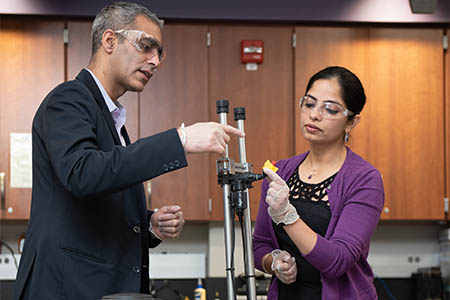 Left: Sharda and her co-principal investigator, Ajay Sharda are creating an autonomous platform that can precisely apply a spray-on biopolymer ground cover.
Left: Sharda and her co-principal investigator, Ajay Sharda are creating an autonomous platform that can precisely apply a spray-on biopolymer ground cover.
Sharda and her collaborators are using a $6 million National Science Foundation Established Program to Stimulate Competitive Research, or EPSCoR, RII Track-2 grant to develop a spray-on biopolymer ground cover that acts as a weed barrier and fertilizer source and helps contain soil moisture. The vision is that once created, this biopolymer product would be sustainable and could replace plastics and chemical herbicides while providing natural fertilization through decomposition.
Current management practices cover soils with sheet plastic to prevent weed growth, erosion and moisture loss during the growing season. But using large amounts of plastic creates waste, is not eco-friendly, is costly and is not economically sustainable for field crops.
“New, locally sourced types of bioplastics that fully break down into safe byproducts can be made,” Sharda said. “These new materials could provide farmers with a green way to control weeds, fertilize crops, protect soil and water resources, and work with nature to better manage their fields.”
Sustainable beef
The livestock industry is an integral part of global food systems as a source of nutrition, income and biodiversity. Balancing demand and improving production practices are needed to make the industry more sustainable.
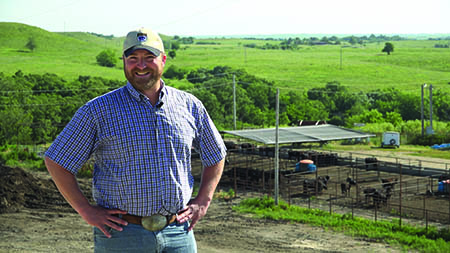 Left: A.J. Tarpoff researches how sun shades can affect animal comfort in weaned calves to improve industry sustainability.
Left: A.J. Tarpoff researches how sun shades can affect animal comfort in weaned calves to improve industry sustainability.
Dale Blasi, professor of animal sciences and industry, and A.J. Tarpoff, associate professor of animal sciences and industry, are examining how precision feeding practices and reducing heat stress in post-weaned calves improve a broad range of sustainability factors.
Limit feeding was first introduced 40 years ago and is a practice of feeding calves nutrient-dense, low-roughage feed once a day. For a recent study, the College of Agriculture duo used corn gluten feed made of byproducts from the ethanol and beverage industry. It is a highly digestible, high-energy bran feed that is proving to be more sustainable and healthier for the animals.
Blasi and Tarpoff found that limit feeding reduces manure output by 40-45%, which reduces emissions, fuel usage and labor needed to clean and dispose of the waste. “The diet they are fed, as opposed to the high-roughage ad lib diet, or grazing diet, is more thoroughly digested and as a consequence, there is less manure output,” Blasi said. “The calves produce less because they utilize more of it in their bodies to create a more efficient gain. And it leaves a smaller footprint and lesser headache for the agriculture industry to worry about disposing of that waste.”
Additionally, the practice has reduced labor, machinery and fuel needs, which makes it economically sustainable while the calves efficiently gain weight.
“There are no detrimental effects of limit feeding in backgrounder, or weaned calf, phase,” Tarpoff said. “We can limit feed them and program their weight gain with a highly digestible feedstuff with no negative attributes at the next level. Ultimately, we’re able to grow each pound of beef more effectively.”
Blasi and Tarpoff are now looking for ways to reduce heat stress on the animals by adding sun shades on the pens during the summer months to reduce the water needs and improve animal comfort.
“We do not have to reinvent the world to make the beef industry sustainable,” Blasi said. “Our job is to account for all the things that we do and make people aware of what is working for us.”
In a separate study, Megan Rolf, associate professor of animal sciences and industry, and her colleagues are looking at gases emitted from grazing cattle to genetically evaluate the gas flux rates in cattle.
By measuring oxygen consumed and methane and carbon dioxide produced from grazing beef cows, Rolf and the research team will be able to use these phenotypes, or observed traits, to build prototype genetic evaluation systems.
Rolf said these new prototypes would provide a blueprint for the inclusion of these traits into genetic evaluation systems so that producers might be able to select cattle based on traits such as methane produced or metabolic rate in the future. Over time, this could lead to increased sustainability through long-term genetic increases in production efficiency.
“By approaching sustainability from a genetic standpoint, changes made over time should be fairly permanent and cumulative over the lifetime of those animals,” Rolf said.
Changing fashion
In the textiles and apparel industry, better sustainability practices are needed, from production to selling to consumer behavior. Researchers in the interior design and fashion studies department in the College of Health and Human Sciences use science, art, education and outreach to create change and awareness.
Kim Hiller, the Barbara Weigand professor in apparel and textiles and fashion studies, is the principal investigator on a project with Melody LeHew, professor of fashion studies. The researchers are using a three-year Sustainable Agriculture Research and Education grant from the U.S. Department of Agriculture to host a hands-on Farm to Fashion camp. The camp is one aspect of their research focused on regenerative and circular fiber, textile and clothing systems.
At the camp, middle and high school youth collaborate with the K-State Sheep and Meat Goat Center and other fashion studies faculty to learn about the fashion supply chain, sustainable fibers and sustainable sheep farming. The goals are to create interest in more sustainable and natural fibers, to change consumer behavior and to spark an interest in the fashion or wool industry in Kansas.
“Our focus in the Farm to Fashion camp is on educating young people to gain an appreciation for where fibers come from and how they are made into textiles and garments,” Hiller said. “They already accept the fact that climate change is a concern and that it is necessary to change behaviors. There’s been such a drastic shift in the mindset of high school and college students in the last ten years. In a lot of ways, it’s easier to change their fashion consumption behaviors if we can help them to understand what the problems are.”
LeHew said the camp uses learning activities based on science, technology, engineering and mathematics, or STEM, to introduce sustainable fashion products and processes, which is the basis of a circular economy.
“The current fashion system is linear, based on ‘take, make and waste’ material use,” LeHew said. “Circular economy is built on the premise that manufactured goods must create zero waste during production and the end of the product life cycle. If designed correctly, textile products become technical nutrients put back into the system or they can be composted as a biological nutrient to enrich the soil.”
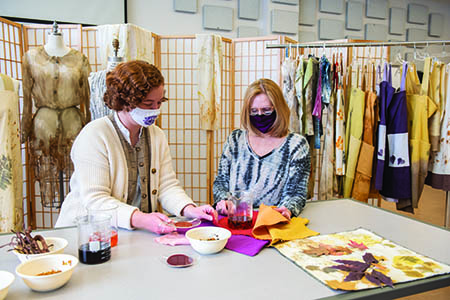 Right: Fashion studies researchers Kelsie Doty and Sherry Haar create fabric designs using natural dyes. (Photo credit: Kelsie Doty)
Right: Fashion studies researchers Kelsie Doty and Sherry Haar create fabric designs using natural dyes. (Photo credit: Kelsie Doty)
To make textile production more sustainable, Sherry Haar, professor of fashion studies, and Kelsie Doty, assistant professor of fashion studies, research and create designs using natural dyes. They investigate colorfastness, natural color fixatives, alternative dyestuffs from waste, all-natural plant dye transfer, metal amounts in effluent water, care methods for naturally dyed textiles, and corporate and local outreach. In addition, both Haar and Doty use the information they glean from research to create fashion designs for juried competitions, which is an essential component of their scholarly work.
Natural dyeing is a practice and technique that the industry had largely forgotten, except in historical reference, until about 10 years ago when the industry really started looking at sustainable business practices.
“Natural dyes are a way to bring together fashion, agriculture and communities in a way that is sustainable for everyone,” said Doty, also the Verna Sullivan-Marler professor in fashion studies.
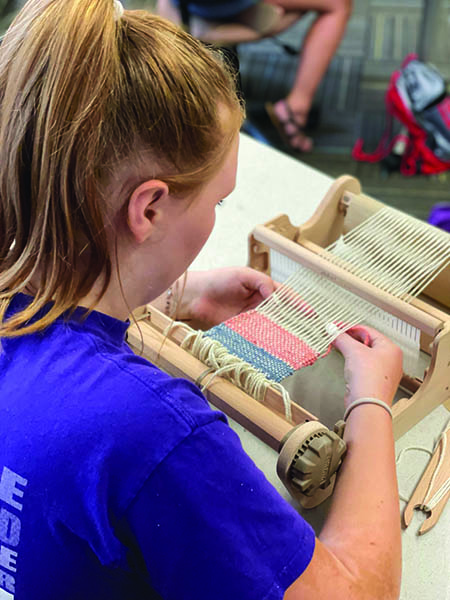 Left: A Farm to Fashion camp participant weaves wool on a tabletop loom. (Photo credit: Kelsie Doty)
Left: A Farm to Fashion camp participant weaves wool on a tabletop loom. (Photo credit: Kelsie Doty)
Sustainability is integrated throughout fashion studies curriculum. For example, in one project students used fabric purchased from and produced by Guatemalan weavers. Students created aprons that were naturally dyed and designed with native flowers and will be auctioned off to sustain the purchase cycle.
Students also learn about sustainable choices in industry and throughout the fashion supply chain.
“We need to educate this generation on how to be better because they are going to be the change-makers to help their companies be sustainable,” Haar said. “They’re going into companies, and they’re asking, ‘What are your sustainability policies?’ and “What are you doing?’”
Leading the change
Understanding how nanomaterials can help build better energy supplies is a research focus for Jun Li, professor of chemistry in the College of Arts and Sciences. Li works to develop more efficient fuel cells and increase the energy capacity of lithium batteries, both of which can help reduce the carbon footprint.
 Right: Jun Li, professor of chemistry, is improving the efficiency of batteries and fuel cells to make the technology more sustainable.
Right: Jun Li, professor of chemistry, is improving the efficiency of batteries and fuel cells to make the technology more sustainable.
Fuel cells convert more energy into electricity with fewer emissions than combustion engines, which makes them a more sustainable option. Li is working to improve the electrocatalysts — the key element to accelerating the electrochemical reactions that convert fuels into electrical energy — in fuel cells. Current technology uses the noble metal platinum as the catalyst, which is costly and unsustainable to produce.
With funding from the U.S. Department of Energy and the National Science Foundation, Li is testing the use of carbon nanomaterials in fuel cell catalysts to reduce the amount of platinum needed and make them more active and stable, leading to more efficient and sustainable energy production.
“We are working to develop new carbon nanomaterials as the supporting material to improve the performance of the catalyst,” Li said. “We can help to improve the electrocatalyst, a critical component in the fuel cells so that they will run more efficiently, be more stable and have a longer lifetime.”
There is also an unending demand for lighter, longer-running batteries. To build a better battery, Li is researching the use of nanomaterials in emerging lithium-sulfur batteries to improve the capacity and safety.
His work replaces the solid lithium metal electrode with a porous, carbon nanomaterial. Lithium is electroplated into the carbon materials’ open space, making it more reversible and safer during the battery charge-discharge process.
“With all the success in powering portable electronics with lithium-ion batteries, there is a strong, neverending demand for lighter and better operating batteries,” Li said. “The future demand for batteries or fuel cells as power sources for larger-scale applications is even bigger — electric cars, electric boats or forklifts in a warehouse. All of these can benefit from better batteries or fuel cells.”
Sustaining the soil
As climate change creates more severe weather episodes — such as floods, drought and high winds — healthy soils are critical for sustainable soil ecosystems.
Charles Rice, university distinguished professor of soil microbiology in the College of Agriculture and a world-renowned researcher in carbon cycling and climate change, is driven to learn how agriculture production systems can be as resilient and efficient as the tallgrass prairie. As part of his work, he was a member of the United Nations Intergovernmental Panel on Climate Change that received the Nobel Peace Prize in 2007.
The three key elements to soil health are carbon, microbial activity and soil structure. Each element relies on the other elements for good soil health, leading to good plant growth, water retention and resiliency during climate change events.
“These elements are intertwined,” Rice said. “The carbon is providing food for the microbes. The microbes are cycling the nutrients and making nitrogen and other nutrients available for the plants, which is important for plant productivity. Finally, soil structure provides air and water movement in and out of the soil.”
One aspect of his research portfolio is carbon sequestration, or practices that restore carbon in the soil. These practices include no-till farming and agriculture diversification, such as cover crops.
According to Rice, soil tillage releases 30-70% of carbon back into the environment. By keeping the soil intact, limiting water evaporation and allowing the plants to naturally take the carbon dioxide out of the air and put it back into the soil, agriculture has the opportunity to mitigate climate change.
“It is a multiple-win scenario,” Rice said. “If we make that soil more resilient and more productive, it is a profitable situation for the farmer. At the same time, if we’re more efficient with the nutrients and the crop rotation diversification, we’re providing a better habitat to protect the environment.”
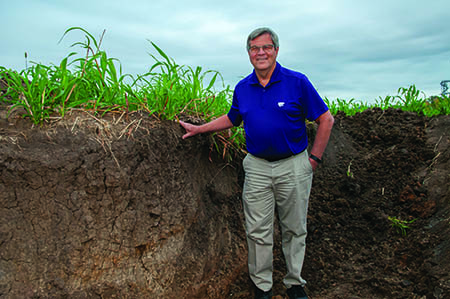 Left: Charles Rice studies sustainable soil ecosystems.
Left: Charles Rice studies sustainable soil ecosystems.
Seek more
